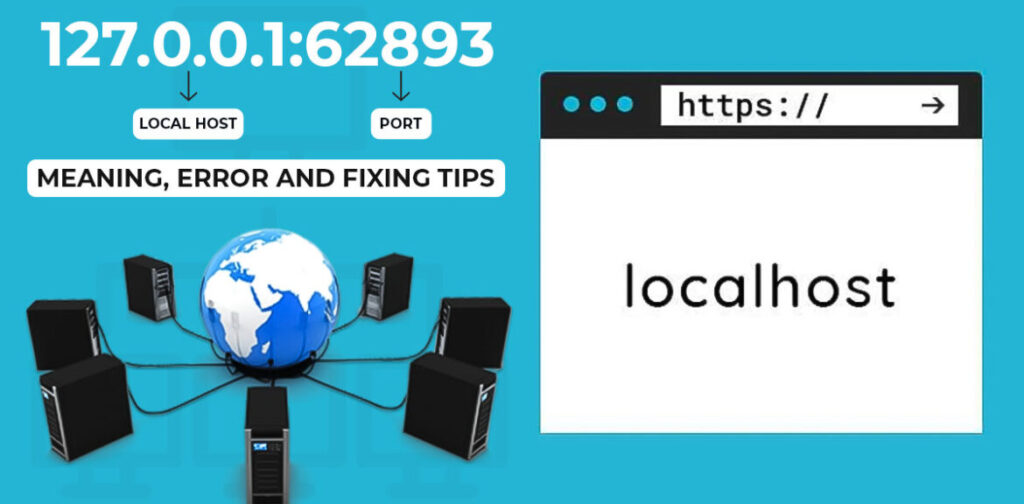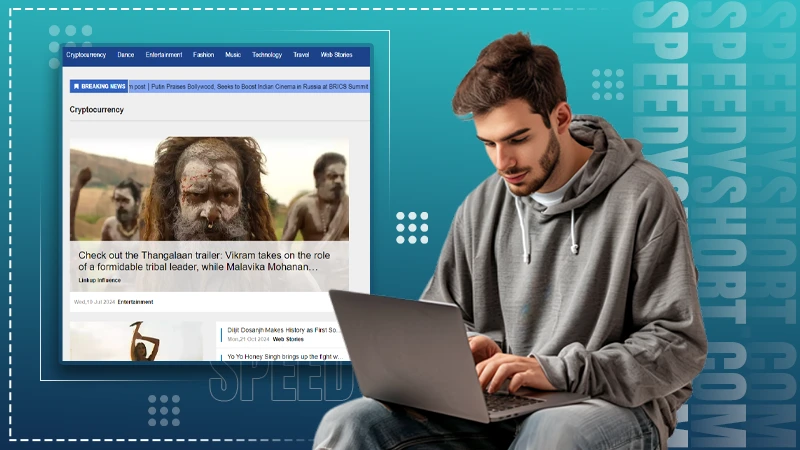127.0.0.1:62893 Explained: Beginner’s Guide to Localhost and Port Testing
Ever seen “127.0.0.1:62893” and felt confused? Don’t worry! In this blog, we’ll explain what “127.0.0.1:62893” means in easy, simple words. This funny number is actually very important for computer geeks and developers.
So, what is 127.0.0.1:62893 ? It’s a secret code that helps your computer talk to itself while you test new programs. It’s like practicing at home before showing your new dance moves to the world. Let’s dive in and learn more!
What Does 127.0.0.1:62893 Mean?

Ever seen “127.0.0.1:62893” and wondered what it means? Simply put, it’s like a secret code for your computer. The first part, “127.0.0.1,” is called the localhost. It’s a special IP address that tells your computer to look at itself. The second part, “62893,” is a port number, which acts like a door where data goes in and out.
Why is 127.0.0.1:62893 important? This combination helps developers test their programs right on their own computers. It’s like practicing your dance moves in front of a mirror before showing them off to your friends. By using 127.0.0.1:62893, they can make sure everything works perfectly before sharing it with others.
Imagine you are building a toy car. Before showing it to your friends, you test it in your room. That’s what 127.0.0.1:62893 does for software. Developers test their software on their computer to find and fix any problems easily.
In short, 127.0.0.1:62893 is super handy for anyone making or fixing software. It makes sure that everything runs smoothly and safely before going live.
Understanding Localhost: 127.0.0.1 Explained

The term “127.0.0.1” might sound confusing, but it’s quite simple. This number is known as the localhost. When you type “127.0.0.1” into your web browser, you’re telling your computer to look at itself. It’s like holding up a mirror and seeing your reflection.
Localhost is very useful for testing and development. Developers use 127.0.0.1:62893 to run their applications locally. This allows them to check how their software behaves without needing the internet. It’s like playing a video game in offline mode to practice before going online.
Think of localhost as a private playground. Only you can play there, and it’s safe from the outside world. This makes 127.0.0.1:62893 a secure place to test new ideas and software features.
Using localhost helps keep your work private and protected. You can experiment freely and fix any issues before making your software public. That’s why 127.0.0.1:62893 is so important in the world of computers.
Why Port 62893 is Special for Developers
Port 62893 might seem like just another number, but it’s special to developers. Ports are like doors that let data enter and exit your computer. Each port has a unique number. Port 62893 is often used by developers for testing and debugging their programs.
When developers use 127.0.0.1:62893, they are opening a specific door for their data. This helps them control and monitor the flow of data easily. It’s like having a special key to a secret room where you can work in peace.
Developers love using port 62893 because it’s not commonly used by other applications. This means fewer conflicts and smoother testing. Imagine having a quiet place to study where no one disturbs you. That’s what port 62893 offers to developers.
Using this port helps ensure that the software runs correctly. Developers can catch errors and fix them before anyone else sees the software. This makes 127.0.0.1:62893 a valuable tool in the development process.
How 127.0.0.1:62893 Helps in Software Testing
Software testing is crucial for making sure programs work well. Using 127.0.0.1:62893 helps developers test their software efficiently. They can run their programs locally and see how they behave without going online.
Testing with 127.0.0.1:62893 is like rehearsing a play before the big performance. Developers can find and fix any mistakes beforehand. This ensures a smooth and error-free experience when the software goes public.
Running tests locally also saves time. Developers don’t need to wait for data to travel over the internet. Everything happens right on their computer. This makes the testing process faster and more efficient.
In summary, using 127.0.0.1:62893 for software testing is smart. It helps developers catch errors early, save time, and ensure their programs run smoothly. This makes the final product better for everyone.
Is 127.0.0.1:62893 Safe? Let’s Find Out
Safety is a big concern when dealing with computers. The good news is that 127.0.0.1:62893 is generally safe to use. Since it’s a localhost address, it doesn’t go out to the internet. This keeps your data protected within your computer.
However, you should still be careful. Make sure only trusted applications use 127.0.0.1:62893. Sometimes, malware can try to sneak in through ports. By monitoring what uses this port, you can keep your computer safe.
Firewalls add another layer of protection. They can block unauthorized access to port 62893. This helps make sure only approved programs use the port. Think of it as a security guard checking IDs at the door.
In conclusion, while 127.0.0.1:62893 is safe, caution is always a good idea. Keep an eye on what’s using the port and use firewalls to ensure maximum security.
Common Errors with 127.0.0.1:62893 and How to Fix Them
Even though 127.0.0.1:62893 is helpful, sometimes you might run into errors. One common problem is the “Disconnected from the target VM” error. This means the debugger couldn’t connect to the specified port.
To fix this, make sure the service or application you’re trying to access is running. Sometimes, simply restarting the application can solve the problem. Also, double-check that the port number 62893 is correct.
Firewall settings can also cause issues. Ensure that your firewall isn’t blocking port 62893. Adjusting the settings to allow traffic on this port can help resolve connection problems.
If you still face issues, consider changing the port number. Sometimes, using a different port can bypass conflicts and get things working again. Always refer to the application’s documentation for specific troubleshooting tips.
Setting Up Your First Local Server with 127.0.0.1:62893
Setting up a local server might sound tricky, but it’s doable! First, make sure you have the right software installed, like a web server or development environment. Next, configure your server to use 127.0.0.1:62893.
Start by opening your server’s configuration file. Look for the part where you can set the IP address and port number. Enter “127.0.0.1” as the IP and “62893” as the port. Save the changes and restart your server.
Once your server is running, open your web browser and type “127.0.0.1:62893” in the address bar. You should see your server’s welcome page or application interface. Congratulations, you’ve set up your first local server!
This local server lets you test and develop your applications safely. By using 127.0.0.1:62893, you can ensure everything works perfectly before going live. Happy coding!
Troubleshooting 127.0.0.1:62893: Easy Tips
Sometimes things go wrong, and you need to troubleshoot 127.0.0.1:62893. Don’t worry; here are some easy tips. First, check if the service you’re trying to access is running. Restarting the service can often fix minor issues.
Next, make sure you’re using the correct port number. If you accidentally typed the wrong number, you won’t be able to connect. Verify that you’re using 62893 and not something else.
Firewall settings are another common culprit. Ensure your firewall isn’t blocking the port. Adjust the settings to allow traffic on 127.0.0.1:62893. This can often resolve connection problems quickly.
Lastly, use diagnostic tools like netstat on Windows or lsof on Unix/Linux to check if any application is already using port 62893. If another application is using the port, change the port number in your configuration.
Firewall Settings for 127.0.0.1:62893
Firewall settings are crucial for securing 127.0.0.1:62893. Firewalls act like security guards, allowing or blocking traffic based on rules. To allow traffic on port 62893, you need to create an exception rule.
On Windows, open the Control Panel and go to Windows Defender Firewall. Click on Advanced Settings, then Inbound Rules. Add a new rule for port 62893, allowing traffic for localhost connections. Save the rule and exit.
For Mac or Linux, use terminal commands like iptables to adjust the firewall settings. Create a rule to allow traffic on port 62893. Make sure to apply and save the changes.
By configuring your firewall correctly, you ensure that 127.0.0.1:62893 remains accessible for necessary applications. This keeps your development environment running smoothly and securely.
Using 127.0.0.1:62893 in Different Operating Systems
Different operating systems handle 127.0.0.1:62893 slightly differently. On Windows, you can use tools like PowerShell or Command Prompt to manage and troubleshoot ports. Running “netstat -a” in Command Prompt can show you all active ports.
On Linux, commands like “lsof -i :62893” can help you see which applications are using port 62893. You might need to use sudo for some commands to get administrative access.
Mac users can also use terminal commands similar to Linux. The Mac operating system is based on Unix, so many of the same commands apply. Tools like Activity Monitor can also help you manage and troubleshoot ports.
Regardless of your operating system, always ensure your firewall settings allow traffic on 127.0.0.1:62893. Proper configuration helps you avoid common issues and keeps your development environment secure and efficient.
Keeping 127.0.0.1:62893 Secure: Best Practices
Security is a top priority when using 127.0.0.1:62893. One of the first steps is to monitor what applications are using this port. Regularly check to ensure only trusted programs are accessing it.
Using strong passwords for your applications can add an extra layer of security. Even though 127.0.0.1:62893 is mostly used locally, it’s still good practice to secure your applications as much as possible.
Firewalls play a crucial role in security. Make sure your firewall settings are correctly configured to allow only necessary traffic on port 62893. Regularly update your firewall rules to adapt to new security requirements.
Finally, keep your software and operating systems updated. Security patches and updates often fix vulnerabilities that could be exploited. By keeping everything up to date, you minimize the risk of unauthorized access through 127.0.0.1:62893.
Fun Facts About 127.0.0.1:62893 You Should Know
Did you know that 127.0.0.1 is called the “loopback” address? It’s like your computer talking to itself. This address is used all over the world by developers and tech enthusiasts alike.
The port number 62893 isn’t just a random number. Ports are like TV channels, each with a unique number. While some ports are famous, like port 80 for websites, others like 62893 are used for specific tasks like testing and debugging.
Another fun fact is that 127.0.0.1 is part of the IPv4 address range. There’s also an IPv6 version of localhost, which looks much longer and more complex. But don’t worry; they both do the same job!
Lastly, did you know that using 127.0.0.1:62893 helps keep your work private and secure? It’s like having a secret lab where you can experiment safely. Now you know more about this cool and useful combination!
I hope these paragraphs and headings fit your needs! If you have any specific preferences or further instructions, feel free to let me know.
Common Errors with 127.0.0.1:62893 and How to Fix Them
Even though 127.0.0.1:62893 is super useful, you might run into some errors when using it. One common problem is the “Connection Refused” error. This often means that the application you’re trying to use isn’t running or isn’t listening to the port correctly.
To fix this, ensure that your application is active and configured to use port 62893. Sometimes a simple restart can make everything work again. Another thing to check is your firewall settings. If your firewall is blocking the port, you won’t be able to connect.
Another error might be “Port Already in Use.” This happens if another application is already using port 62893. You can either stop that application or change your application’s port number to another one. Tools like netstat or lsof can help you find out which app is using the port.
Firewall settings can also cause problems. Make sure your firewall isn’t blocking 127.0.0.1:62893. Adjusting the firewall to allow traffic on this port can often solve the issue quickly.
Setting Up Your First Local Server with 127.0.0.1:62893
Setting up a local server using 127.0.0.1:62893 is easier than you think! First, download and install a web server, like Apache or Nginx. Once installed, open the configuration file where you can set the IP address and port number.
In the configuration file, you’ll see sections for IP and port. Set the IP to “127.0.0.1” and the port to “62893”. Save your changes and restart your server. Now, your server is set to listen to 127.0.0.1:62893.
Open your web browser and type “127.0.0.1:62893” in the address bar. If everything is set up correctly, you should see your server’s welcome page or the application interface. Congrats, you’ve successfully set up your first local server!
Using 127.0.0.1:62893 for your local server helps you test and develop safely. You can check how your applications behave without affecting the internet. It’s like cooking in your kitchen before serving guests.
Tools for Controlling Localhost and Ports
Several tools can help you manage and control 127.0.0.1:62893 and other ports. One popular tool is Wireshark, which lets you analyze network traffic. It helps you see what data is coming in and out through port 62893.
PortQry is another handy tool. It’s used to query open ports and check their status. By using PortQry, you can find out if port 62893 is open or blocked. This helps in troubleshooting and ensures smooth operation.
Nmap is excellent for network discovery and security audits. It scans your system and shows which ports are open and what services are using them. Using Nmap, you can monitor 127.0.0.1:62893 and ensure it’s being used correctly.
These tools make managing localhost and ports much easier. They provide insights and control over your network, helping you keep things running smoothly and securely.
Does Port 62893 Open to the Public? Let’s Find Out

Port 62893 is usually not open to the public. It’s primarily used for local development and testing. Keeping it private helps protect your computer from unauthorized access and potential attacks.
Opening port 62893 to the public can expose your system to risks. Cybercriminals might try to exploit this open port to gain access or launch attacks. It’s like leaving your house door unlocked; anyone could walk in.
To keep things secure, configure your firewall to block external access to port 62893. This ensures only local traffic is allowed. Always check your firewall and security settings regularly to avoid any vulnerabilities.
In summary, while it’s technically possible to open port 62893 to the public, it’s not recommended. Keeping it private helps maintain the security and integrity of your development environment.
Conclusion
127.0.0.1:62893 might look like a random collection of numbers, but it’s really important in the tech world. It allows developers to test and debug their applications safely on their own computers. Understanding and using 127.0.0.1:62893 can make your software development process much smoother.
Troubleshooting common errors, configuring firewalls, and using helpful tools can enhance your experience with 127.0.0.1:62893. By keeping it secure and private, you ensure a safe and efficient workflow.
Remember, 127.0.0.1:62893 is like a secret lab. You can experiment, test, and perfect your software before sharing it with the world. I hope this guide has made the concept clearer and more approachable. Happy coding!












